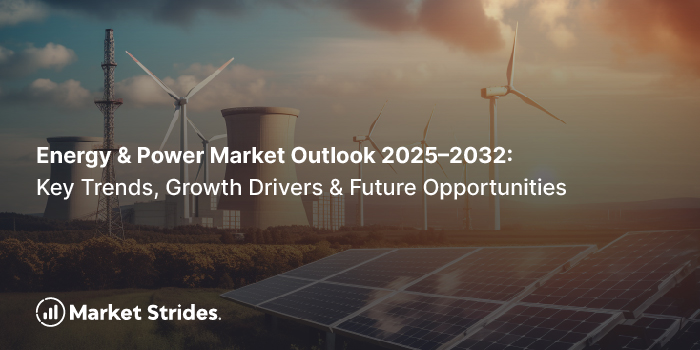Energy & Power Market Outlook 2025–2032: Key Trends, Growth Drivers & Future Opportunities

Energy & Power Market Outlook 2025–2032
The global Energy & Power sector is undergoing rapid transformation. Falling renewable costs, advanced storage solutions, decentralization, hydrogen adoption, and stronger climate policies are reshaping power systems worldwide. This article covers 10 essential categories shaping the energy transition and includes direct links to detailed market reports across global, regional, and country-level pages.
Battery Storage Systems
Battery storage is becoming the backbone of modern grids, enabling flexible energy supply, frequency regulation, and renewable integration. Core technologies such as Battery Pack & Modules, Nickel-Zinc Batteries, and Zinc-Bromine Batteries are increasingly deployed in utility-scale, commercial, and residential systems.
Advanced chemistries such as Printable Batteries support the growing demand for wearables, IoT sensors, and micro-storage environments. Regional deployments, especially in the United States and North America, continue to surge as utilities modernize their grids.
Renewable Energy (Solar, Wind, Hydro)
Solar and wind remain the fastest-growing power generation technologies. Emerging innovations such as Plastic Solar Cells and Dye-Sensitized Solar Cells add new flexibility for lightweight and portable energy applications.
Hybrid solar-plus-storage systems are increasingly preferred in commercial and utility installations. Countries in Europe and Asia are rapidly expanding solar parks, with local manufacturing helping stabilize supply chains and lower costs.
Hydrogen & Alternative Fuels
Hydrogen has become a critical component for decarbonizing heavy industries and transport. The maritime sector is exploring alternatives such as ammonia-fueled propulsion. For insights, see the Ammonia-Fuelled Ships Market (Global) and region-level markets including United States and Asia Pacific.
Hydrogen adoption for mobility and industrial use continues to rise, supported by portable generation systems such as those covered in the Portable Hydrogen Generator Market. Refineries are also transitioning through blue hydrogen pathways, detailed in the Petroleum-Refining Blue Hydrogen Market.
Electricity Generation
Traditional power plants gas, thermal, and emerging small modular nuclear units remain essential for stability as renewable penetration grows. Flexible gas turbines support rapid balancing and peak demand management, while distributed generation models are becoming more common in commercial facilities.
Countries modernizing thermal fleets often integrate storage or hybrid upgrades to extend asset life. These changes improve efficiency and reduce operational emissions.
Energy Efficiency
Energy efficiency delivers immediate benefits for both industrial and residential customers. Digitized building management, IoT-based monitoring, and AI-enabled optimization tools reduce operational costs while improving sustainability metrics.
The rise of performance contracting and pay-as-you-save models is accelerating adoption across emerging markets, particularly in Asia and North America.
Energy Equipment & Turbines
Manufacturers are improving the efficiency, durability, and fuel compatibility of new-generation engines and turbines. The High-Speed Diesel Engines Market remains crucial for marine, industrial, and backup power applications.
Aftermarket services such as component upgrades, hydrogen-ready retrofits, and blade repair are becoming significant revenue drivers for OEMs.
Power Transmission & Distribution
Modernizing transmission and distribution networks is essential for integrating large-scale renewables. Investments in HVDC links, grid automation, AI-based load forecasting, and system resilience upgrades are increasing worldwide.
Countries with high renewable penetration are accelerating grid-forming inverter deployments and flexible interconnector projects to stabilize energy flows.
Off-Grid & Decentralized Power
Microgrids, mini-grids, and pay-as-you-go solar systems are expanding access in rural regions and powering commercial facilities where reliability is critical. These decentralized systems combine solar PV, batteries, generators, and smart controllers for seamless operation.
Emerging markets in Asia, Africa, and Latin America are seeing strong growth in household-level solar kits and community-scale microgrids.
Oil & Gas (Transition Dynamics)
Oil & gas companies are optimizing production for lower emissions while investing in carbon capture, hydrogen and renewable power integration. Blue hydrogen and refinery transformation strategies are mapped in detail in the Blue Hydrogen Refinery Market.
Upstream operators are adopting digital monitoring, methane reduction technologies and electrified operations to remain competitive in a carbon-sensitive market.
Conclusion
The Energy & Power sector is moving toward a more flexible, efficient, and low-carbon future. Whether through advanced storage, next-generation solar materials, hydrogen-based fuels, or smarter grids, each component contributes to a more resilient and sustainable energy ecosystem. Use the embedded report links above to explore detailed global and regional market insights for strategic planning.